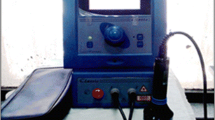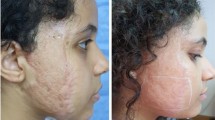Abstract
For over several decades, 595-nm pulsed dye laser (PDL) has been used effectively, reducing erythema and improving the pliability and texture of burn scars. Children usually tolerate PDL treatment as it is non-invasive and causes only mild pain compared to other laser treatments. However, currently, there are limited data on scar management in children who underwent PDL treatment, especially for Fitzpatrick skin types III and IV. The objective of the study was to identify the optimal parameters for the PDL treatment that induce inhibitory effects on scar tissue in children with Fitzpatrick skin types III and IV. Besides, the study assessed the usefulness of high-frequency ultrasound (20 MHz) and laser Doppler flowmetry in assessing these lesions. A total of 165 (79 males and 86 females) children with hypertrophic scars treated by PDL were assessed by the Vancouver scar scale (VSS), high-frequency ultrasound (20 MHz), and laser Doppler flowmetry. The parameters used for the 595-nm PDL treatment were pulse duration of 0.45 ms, fluence between 5 and 9 J/cm2, a spot size of 7 mm, and treatment intervals from 3 to 8 weeks. There were no significant differences between pretreatment and post-treatment in terms of the distribution of sex, type of skin color, and low and high fluences. While the mean scores of all scar parameters based on VSS, except thickness and pliability between pre and post-treatment, showed significant differences in ≤3-year-old children vs. to >3-year-old children, except for the subscore, a significant improvement was observed when PDL was initiated within 4 to 6 months of the scar age. In Chinese children with Fitzpatrick skin types III and IV, early intervention, appropriate treatment intervals, and low fluence of PDL were optimal parameters in treating hypertrophic burn scars. The combined high-frequency ultrasound and laser Doppler flowmetry assessment of scars helped assess these lesions and compare the efficacy of different treatment modalities.




Similar content being viewed by others
References
Liuzzi F, Chadwick S, Shah M (2015) Paediatric post-burn scar management in the UK: a national survey. Burns. 41(2):252–256
Lv K, Xia Z (2018) Chinese consensus panel on the prevention and treatment of scars. Burns Trauma. 17:6–27
Deitch EA, Wheelahan TM, Rose MP, Clothier J, Cotter J (1983) Hypertrophic burn scars: analysis of variables. J Trauma. 23(10):895–898
Khansa I, Harrison B, Janis JE (2016) Evidence-based scar management: how to improve results with technique and technology. Plast Reconstr Surg. 138(3 Suppl):165S–178S
Krakowski AC, Totri CR, Donelan MB, Shumaker PR (2016) Scar management in the pediatric and adolescent populations. Pediatrics. 137(2):e20142065
Gold MH, McGuire M, Mustoe TA, Pusic A, Sachdev M, Waibel J, Murcia C (2014) Updated international clinical recommendations on scar management: part 2--algorithms for scar prevention and treatment. Dermatol Surg. 40(8):825–831
EL-Hoshy K, Abdel-Halim M, Dorgham D, Sayed SS, El-Kalioby M (2017) Efficacy of fractional carbon dioxide laser in the treatment of mature burn scars:a clinical, histopathological, and histochemical study. J Clin Aesthet Dermatol. 10(12):36–43
Ozog DM, Liu A, Chaffins ML, Ormsby AH, Fincher EF, Chipps LK (2013) Evaluation of clinical results, histological architec- ture, and collagen expression following treatment of mature burn scars with a fractional carbon dioxide laser. JAMA Dermatol. 149(1):50–57
Żądkowski T, Nachulewicz P, Mazgaj M, Woźniak M, Cielecki C, Wieczorek AP, Beń-Skowronek I (2016) A new CO2 laser technique for the treatment pediatric hypertrophic burn scars: an observational study. Medicine. 95(42):e5168
Reiken SR, Wolfort SF, Berthiaume F, Compton C, Tompkins RG, Yarmush ML (1997) Control of hypertrophic scar growth using selective photothermolysis. Lasers Surg Med. 21(1):7–12
Allison KP, Kiernan MN, Waters RA, Clement RM (2003) Pulsed dye laser treatment of burn scars: alleviation or irritation? Burns 29(3):207–213
Lin L, Guo P, Wang X, Huo R, Li Q, Yin S, Cao Y (2019) Effective treatment for hypertrophic scar with dual-wave-length PDL and Nd:YAG in Chinese patients. J Cosmet Laser Ther. 21(4):228–233
Alsharnoubi J, Mohamed O (2018) Photobiomodulation effect on children’s scars. Lasers Med Sci 33(3):497–501
Stewart TL, Ball B, Schembri PJ, Hori K, Ding J, Shankowsky HA, Tredget EE (2012) The use of laser Doppler imaging as a predictor of burn depth and hypertrophic scar post burn injury. J Burn Care Rehabil. 33:764–771
Haurani MJ, Foreman K, Yang JJ et al (2009) 5-Fluorouracil treatment of problematic scars. Plast Reconstr Surg. 123:139–148 discussion 149
Payapvipapong K, Niumpradit N, Piriyanand C (2015) The treatment of keloids and hypertrophic scars with intralesional bleomycin in skin of color. J Cosmet Dermatol. 14:83–90
Hayashi T, Furukawa H, Oyama A (2012) A new uniform protocol of combined corticosteroid injections and ointment application reduces recurrence rates after surgical keloid/hypertrophic scar excision. Dermatol Surg. 38(6):893–897
Alster TS, Nanni CA (1998) pulsed dye laser treatment of hypertrophic burn scar. Plast Reconstr Surg. 102(6):2190–2195
Ha JM, Kim HS, Cho EB, Park GH, Park EJ, Kim KH, Kim LS, Kim KJ (2014) Comparison of the effectiveness of non-ablative fractional laser versus pulsed-dye laser. Ann Dermatol. 26(5):615–620
Shin JU, Gantsetseg D, Jung JY, Jung I, Shin S, Lee JH (2014) Comparison of non-ablative and ablative fractional laser treatments in a postoperative scar study. Lasers Surg Med. 46(10):741–749
Manuskiatti W, Fitzpatrick RE, Goldman MP (2001) Energy density and numbers of treatment affect response of keloidal and hypertrophic sternotomy scars to the 585-nm flashlamp-pumped pulsed-dye laser. J Am Acad Dermatol. 45(4):557–565
Liew SH, Murison M, Dickson WA. Prophylactic treatment of deep dermal burn scar to prevent hypertrophic scarring using the pulsed dye laser: a preliminary study. Ann Plast Surg. 2002;49(5):472–5.
Chan HH, Wong DS, Ho WS, Lam LK, Wei W. The use of pulsed dye laser for the prevention and treatment of hypertrophic scars in Chinese persons. Dermatol Surg. 2004;30(7):987–94; discussion 994.
Zhu R, Yue B, Yang Q, Ma Y, Huang G, Guan M, Avram MM, Lu Z. The effect of 595 nm pulsed dye laser on connective tissue growth factor (CTGF) expression in cultured keloid fibroblasts. Lasers Surg Med. 2015;47(2):203–9.
Tan OT, Murray S, Kurban AK (1989) Action spectrum of vascular specific injury using pulsed irradiation. J Invest Dermatol. 92:868–871
Draaijers LJ, Tempelman FR, Botman YA, Kreis RW, Middelkoop E (2006) Colour evaluation in scars: tristimulus colorimeter, narrow- band simple reflectance meter or subjective evaluation? Burns. 30:103–107
Tucker DI, Stanley B, Segroves W, Aden J, Renz EM, King BT, Chan RK (2015) Quantitative assessment of pulse dye laser therapy in the management of hypertrophic burn scars. Ann Clin and Lab Res. 3(4):35–42
Reinholz M, Schwaiger H, Poetschke J, Epple A, Ruzicka T, Von Braunmühl T, Gauglitz G (2016) Objective and subjective treatment evaluation of scars using optical coherence tomography, sonography, photography, and standardized questionnaires. Eur J Dermatol. 26(6):599–608
Nakagawa H, Tan OT, Parrish JA (1985) Ultrastructural changes in human skin after exposure to a pulsed laser. J Invest Dermatol. 84(5):396–400
Elrefaie AM, Salem RM, Faheem MH (2019) High-resolution ultrasound for keloids and hypertrophic scar assessment. Lasers Med Sci 35(2):379–385
Bessonart MN, Macedo N, Carmona C (2005) High resolution B-scan ultrasound of hypertrophic scars. Skin Res Technol. 11:185–188
Acknowledgments
We thank Mrs Aiping Guo for her help in field measurements and statistics analyses, and Medjaden Bioscience Limited Corporation significantly improved English writing this manuscript.
Funding
The study was funded by Xijing Hospital Clinical Foundation.
Author information
Authors and Affiliations
Contributions
Na Li, Li Yang, Jing Cheng: PDL treatment, data statistics, and paper writing.
Xuekang Yang, Zhao Zheng, Hao Guan, Dahai Hu: all hypertrophic scar cases provided.
Juntao Han and Dahai Hu: making research approach and article structure.
Corresponding author
Ethics declarations
Conflict of interest
The authors declared that they have no conflicts of interest in this work.
Statement of ethics
The study was approved by the Ethics Committee of Xijing Hospital, Xi’an, China. All guardians of the patients have provided written informed consent, including permission for publishing their images.
Additional information
Publisher’s note
Springer Nature remains neutral with regard to jurisdictional claims in published maps and institutional affiliations.
Rights and permissions
About this article
Cite this article
Li, N., Yang, L., Cheng, J. et al. A retrospective study to identify the optimal parameters for pulsed dye laser in the treatment of hypertrophic burn scars in Chinese children with Fitzpatrick skin types III and IV. Lasers Med Sci 36, 1671–1679 (2021). https://doi.org/10.1007/s10103-021-03252-x
Received:
Accepted:
Published:
Issue Date:
DOI: https://doi.org/10.1007/s10103-021-03252-x




